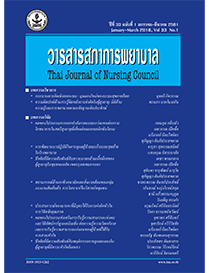Situation of Occupational and Environmental Health Among Garment Workers: An Analysis of Community Enterprise
Keywords:
garment workers, workplace hazards, work-related illnesses and injuriesAbstract
Abstract
Objective: To analyze the situation of occupational and environmental health among
garment workers working at community enterprises
Design: Descriptive study
Methodology: The study sample was 330 garment workers at community enterprises
in Sankampaeng District, Chiang Mai province. Interview forms were used to collect
data on (1) occupational health hazards; (2) health conditions related to risks; and
(3) working behaviour. Data were analyzed using descriptive statistics.
Results: Three most signifcant workplace hazards were identifed. These included
ergonomic hazard which were awkward, repetitive postures, and prolonged sitting
(87.6-97.0%); chemical hazard which was fabric dust (96.4%); and psychosocial
hazards including inconsistent incomes and rush working (80.0-83.0%). Unsafe
working conditions were linked to working with sharp tools (97.0%) or electricity-powered
machines (96.1%). The most common work-related illnesses were musculoskeletal
disorders (90.0%), and work-induced stress caused by inconsistent incomes and rush
working (55.2%). Work-related injuries during the past three month were 18.2% which
were non-fatal injuries. The injury causation was related to sharp tools (81.3%).
Concerning working behaviour, more than half of the samples adopted personal
protective equipment, whilst nearly two-thirds checked their appliances’ conditions
before use.
Recommendations: In order to improve garment workers’ quality of working
life, it is suggested that occupational health team place high importance on health protection,
effectively communicate work-related risks to workers, develop management strategies
for musculoskeletal disorders and work-induced stress, and continuously promote safe
working behavior.
Downloads
References
2. Kelly M, Strazdins L, Dellora T, Khamman S, Seubsman S, Sleigh AC. Thailand’s work and health transition. International Labour Review 2010; 149(3), 371-86.
3. Schneider F, Buehn A, Claudio E. Montenegro shadow economies all over the world: New estimates for 162 countries from 1999 to 2007 (Policy Research Working Paper 5356) [Internet] 2010 [cited 2017 November 1] Available from https://www.ilo.org/public/libdoc//igo/2010/458650.pdf
4. Thailand National Statistic Offce. The informal employment survey 2016 [Internet] 2009 [cited
2017 December 6] Available from https://service. nso.go.th (In Thai)
5. International Labour Organization [ILO]. Decent work and the informal economy (International Labour
Conference, 90th Session, Report VI). Geneva, Switzerland: Author; 2002.
6. Florey LS, Sandro G, Wilson MS. Macrosocial determinants of population health in the context of globalization. In Sandro Galea (ed.), Macrosocial determinants of population health. New York: Springer; 2007.
7. Economic and Social Commission for Asia and the Pacifc [ESCAP]. Improving vital statistics and cause
of death statistics: The experience of Thailand. Committee on Statistics: Bangkok; 2008.
8. Khan NR, Dipti TR, Ferdousi SK, Hossain MZ, Ferdousi S, Sony SA..., Islam MS. Occupational health hazards among workers of garment factors in Dhaka city, Bangladesh. JDMC 2015; 24(1),36-43.
9. Innama S. Informal labor force: Working life health and social care: A case study of sewing worker. JPHR 2010; 4, 379-92.
10. Silpasuwan P, Prayomyong S, Sujitrat D, Suwan-ampai P. Cotton dust exposure and resulting respiratory disorders among home-based garment workers. Workplace Health & Safety 2015; 64(3), 95-102.
11. WIEGO. Home-based workers [Internet] 2009 [cited 2017 November 10] Available from https:// www.weigo.org/wee/home-based-workers
12. Ahmed S, Raihan MZ. Health status of the female workers in the garment sector of Bangladesh. JEAS
2014; 4(1), 43-58.
13. Berberoglu U, Tokuc B. Work-related musculoskeletal disorders at two textile factories in Edirne, Turkey. BMJ 2013; 30(1), 23-7.
14. Islam LN, Sultana R, Feadous KJ. Occupational health of garment worker in Bangladesh. JE 2014;
1(1), 21-4.
15. Padmini DS, Venmathi A. Unsafe work environment in garment industries, Tirupur, India. JERAD 2012;
7(1), 569-75.73
16. Nahar N, Ali RN, Begum F. Occupational Health Hazards in Garment Sector. Headache 2010;86,95-6.
17. Levy BS, Wegman DH, Baron SL, Sokas RK. Occupational and environment health: recognizin and preventing disease and injury. USA: Lippincott;2011.
18. Akhtar S, Shimul AM. Working hazards as indicator of occupational stress of industrial worker of Bangladesh. Asian Business Review 2012; 1(1), 141-4.
19. Silva PD, Lombardo S, Lipscomb H, Grand J, Ostbye T. Health status and quality of life of female garment workers in Sri Lanka. GMJ 2013; 18(1), 63-9.
20. Tunyaboontrakul P. Hazard preventive behavior from cotton dust among workers in Thai garment export company [dissertation online] 2010 [cited 2018 January 6] Available from https://dric.nrct.go.th/get_fulltext.php bookid=258118&absid=D RL000602 (In Thai)
21. Krejcie R, Morgan DW. Determining sample size for research activities. EPM 1970; 30, 607-10.
22. National Statistical Offce. The informal employment survey [internet] 2017 [cited 2018 March 29] Available from www.nso.go.th
23. Polat O, Kalayci CB. Ergonomic risk assessment of workers in garment industry [Internet] 2016 [cited 2017 December 6] Available from https://www.researchgate.net/publication/309321719_Ergonomic_Risk_Assessment
24. Maksri P. Occupational health hazards and health status related to risk among informal garment workers [dissertation]. Faculty of Nursing, Chiang Mai University; 2016. (In Thai)
25. Chaiklieng S, Suggaravetsiri P, Puntumetakul R. Prevalence and risk factors for work-related shoulder pain among informal garment workers in the northeast of Thailand. Small Enterprise Research 2014;21(2), 180-9.
26. Serinken M, Türkçüer İ, Dağlı B, Karcıoğlu Ö, Zencir M, Uyanık E. Work-related injuries in textile industry workers in Turkey. Ulus Travma Acil Cerrahi Derg 2012; 18(1), 31-6.
27. Belshé K, Bradshaw L, Horton B. Hesis hazard evaluation system & Information service. California Department of Public Health [Internet] 2009 [cited 2017 December 6] Available from www.cdph.ca.gov/programs/OHB.
28. Athit K. Hazards in Combodian garment factories. Asian Labour Update 2005; 55(1), 1-3.
29. Jahan N, Das M, Mondal R, Paul S, Saha T, Akhtar R, ... , Banik PC. Prevalence of Musculoskeletal Disorders among the Bangladeshi Garments Workers. SMU Medical Journal 2014; 2(1), 102-13.
30. International Labour Organization [ILO]. Safety and health in the use of machinery (ILO code of practice). Geneva, Switzerland: International Labour Offce; 2013.
31. Chau N, Wild P, Dehaene D, Benanghar L, Mur JM, Touron C. Roles of age, length of service and job in workrelated injury: a prospective study of 446 120 personyear in railway workers. Occup Evniron Med 2010; 67, 147-53.








